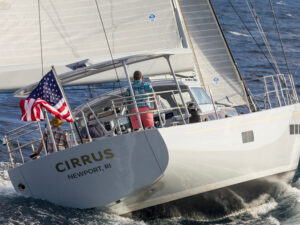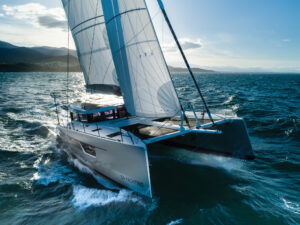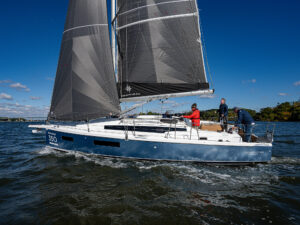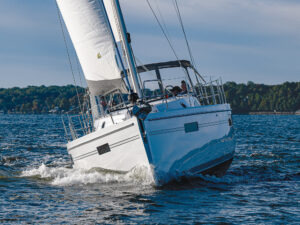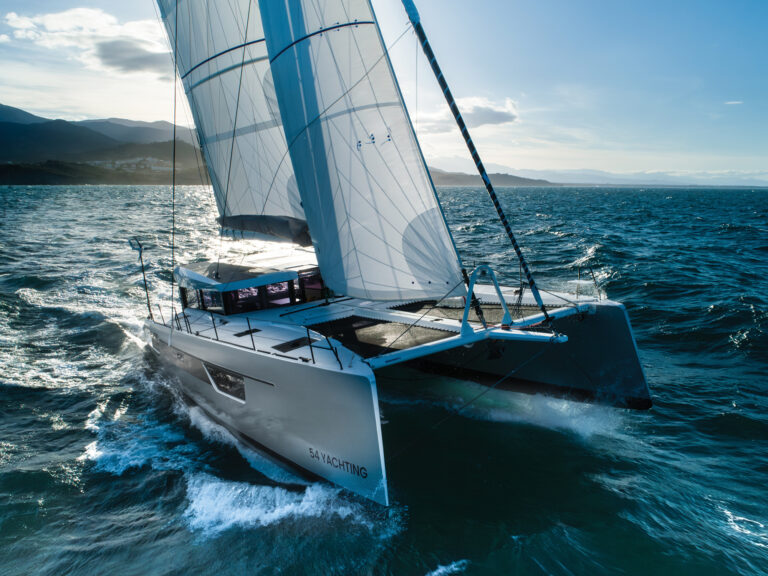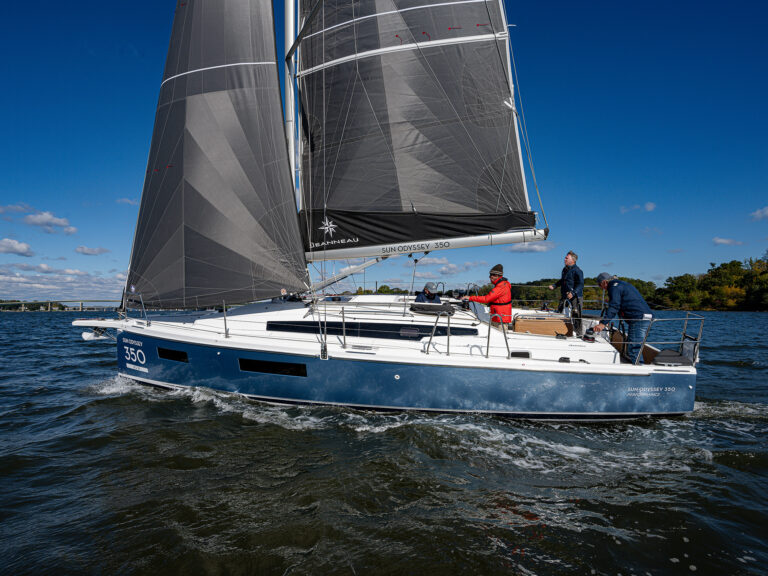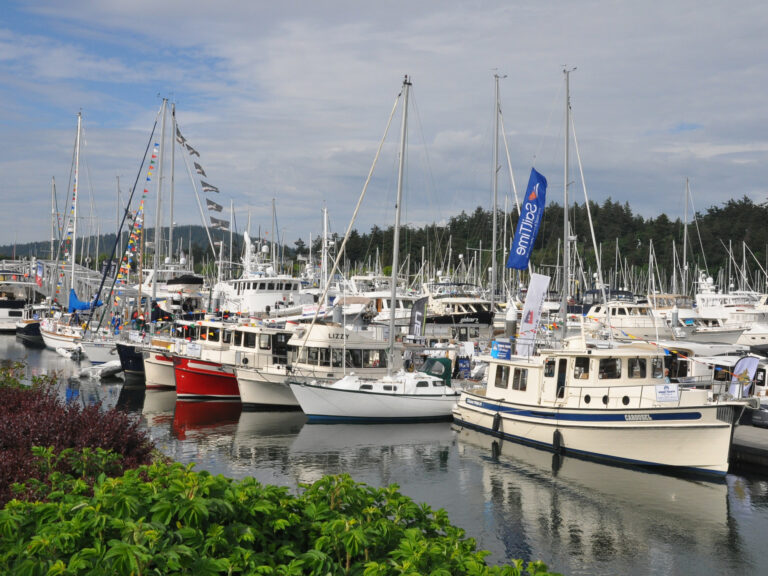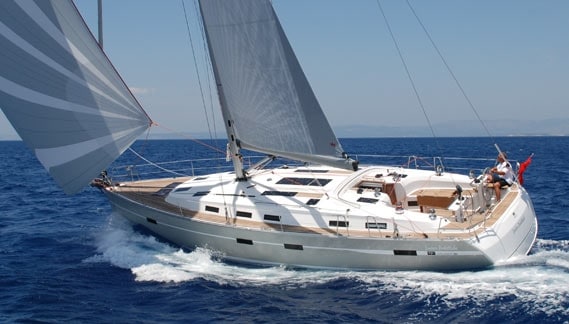
As far as boat tests go, I could’ve been easily distracted during my sail aboard the Bavaria 50 Cruiser, the last in the model line to be revamped by the team at Farr Yacht Design. First, the arid, rock-strewn hills of the Turkish coast around Alacati were like nothing I’d ever seen. Greek isles danced in the distance. Atop the surrounding ridges, farms of wind generators stood testament to the fact that this area of the Aegean is among the windiest to be found and the ideal exotic proving grounds for Germany’s largest boatbuilder.
And then there was the wind itself to talk about, or, to be more precise, the totally baffling near-complete lack of it, which had us bobbing about much of the morning before we motored in for lunch, hoping that the afternoon’s heat might scare up a breeze.
The 50 Cruiser, though, and the crew from Bavaria managed to command my full attention as we motored out and back, the 75-horsepower Volvo and optional Gori propeller pushing us along at a very respectable cruising speed of 7.6 knots at 2,200 rpm and at 8.5 knots or better with the engine wide open. For yuks, I throttled back and threw the power plant into reverse. We came to a sharp halt, backed and turned with ease, and, once under way again, took a tight spin and watched the 50 twirl around, upright and within a boat length and a half of itself. Under power, at least, this all-round-sailer delivered an agile performance.
Post lunch, we’d learn that the boat was a spritely light-air sailer, too.
To be honest, this was the first of the Farr-designed Bavarias that I’d been aboard, and I was struck immediately by the solid feel of the boat and the well-thought-out layout on deck and below. From the dock, we stepped aboard the electric-powered fold-down transom and swim platform, which provided uncluttered access to a cockpit that was flanked at its aft end by a split backstay and twin pedestals with Lewmar wheels and rack-and-pinion steering. A sturdy cockpit table provided a good handhold and could double as a place to brace when the boat heels. In addition to teak on the cockpit sole and swim platform, the model we sailed had optional teak decks that provided solid footing forward.
The double-spreader Seldén in-mast furling main is controlled by a sheet led to a cabin-top winch, an arrangement that’s typical on cruising boats but puts control of the sail several steps away from a singlehanded or short-crewed helmsman. Sheets for the slightly overlapping 106-percent genoa (on a Furlex furler) run to fairleads inboard on the cabin top, and from there to electric winches on the cockpit coamings, leaving the side decks free from clutter and making sail control a fingertip exercise. However, one does have to leave the wheel and step forward around the helm and between the table and seats to handle sheets when tacking.
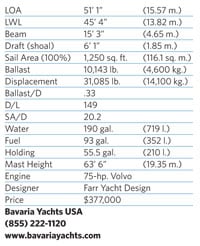
Under sail, in 9 knots true, we hit just under 7 knots and tacked through 85 degrees. Still, it left me wanting more. The smooth-feeling steering led me to believe that with a little more wind, we’d have heeled smartly, the leeward of the twin rudders would’ve dug in, and we’d have been off for a spirited beat or, better yet, a reach like the one enjoyed by a Bavaria 50 owner with whom I spoke that evening following his arrival from a several-day sail from the Med.
Belowdecks, the 50 is downright spacious, with the saloon laid out to accommodate a crowd. A U-shaped amidships galley to port keeps the cook a part of the party, and the amply sized table with U-shaped seating to starboard and an amidships bench could easily seat eight. I liked the idea of the head to starboard of the companionway and just forward of that side’s aft cabin. It has a separate shower that can double as a place to store wet foulies. A private head and sink is to port for the other aft double. The four-cabin model we tested had a cabin forward of the galley with two bunks and a head and shower opposite to starboard. A large owner’s cabin and V-berth were forward, just aft of a water-tight bulkhead and the deep chain locker in the bow.
Three other layouts are available: a three-cabin model with an enormous owners space forward that includes a large head and shower to port and extended hanging lockers to starboard; a four-cabin layout that splits the V-berth in two, each side with its own head; and a five-cabin model with the split V-berth, a shared head forward, and a cabin with two bunks. The interior is well lit and airy, thanks to 17 opening hatches and 12 ports, and comes with wood and sole options that range from light-colored ones to dark chestnut.
Farr has drawn a hull shape with a fairly fine entry, broad shoulders, and a beam that’s carried aft. The layup consists of gelcoat and a layer of vinylester resin outboard, then solid hand-laid polyester and glass below the waterline and a glass-and-Airex foam sandwich above. The deck is Airex cored as well, with integral aluminum plates in the laminate where hardware is mounted.
Intended to be a well-rounded cruiser for both the private owner and charterer, the Bavaria 50 delivers good value with its $377,000 price tag. Add performance into the equation, and it’s hard not to enjoy an afternoon out on the 50 Cruiser. With a little wind and a destination in mind, a week or more wouldn’t be so bad, either.
Mark Pillsbury is CW‘s editor.

